Trail tyres embody the ultimate versatility for adventurous riders, combining exceptional grip on and off-road thanks to their unique design that blends an aggressive tread pattern with reinforced structure.
Choosing the right trail tyres is crucial for enjoying an optimal and safe riding experience during your off-road adventures. Their ability to adapt to various terrains, from asphalt roads to rugged trails, makes them a key element for limitless exploration freedom.
What are trail tyres?
Trail tyres, designed for off-road motorcycles, embody versatility and robustness.
Definition and main characteristics
Their unique design combines an aggressive tread pattern with a robust structure, offering exceptional grip on a variety of surfaces, from asphalt roads to rugged trails.
Their reinforced sidewalls ensure impact resistance and increased durability, while their adapted profile allows for optimal handling, even in difficult conditions.
Differences with other types of motorcycle tyres
Unlike traditional road tyres, trail tyres stand out for their ability to tackle a multitude of terrains. Designed to offer a balance between on-road grip and off-road performance, they also differ from pure off-road tyres by their ability to maintain stable riding at higher speeds on asphalt.
Their versatile tread pattern combines deep tread blocks for maximum off-road traction and lateral grooves to channel water on wet roads, ensuring safe riding in various conditions.
Advantages of using trail tyres for riders
Opting for trail tyres offers riders limitless exploration freedom. Their ability to adapt to a wide range of terrains allows adventurers to confidently conquer new horizons. Whether for an off-road escape in the countryside or a ride on winding roads, trail tyres offer reliable and versatile performance.
Their durability and resistance to damage ensure safe riding, even in demanding conditions, providing riders with peace of mind throughout their journey.
The different types of terrains and their requirements for trail tyres
Their robust construction guarantees reliable performance even in the most hostile environments, allowing riders to explore extreme terrains with confidence.
On-road: stability and grip
Unlike standard tyres, they are specially designed to offer exceptional performance even on the most demanding asphalt surfaces. Their specific tread pattern ensures efficient water evacuation, thus reducing the risk of aquaplaning and ensuring safe riding in wet conditions.
Additionally, their robust construction and reinforced sidewalls guarantee high-speed stability, offering riders a smooth and secure on-road riding experience.
Light off-road: traction and handling
In light off-road conditions, trail tyres must offer exceptional traction and optimal handling. Their aggressive tread pattern, with deep and spaced blocks, ensures maximum grip on loose surfaces such as dirt, sand, and gravel.
Moreover, their flexible construction allows for controlled deformation, providing additional traction during tight turns and steep climbs. With suitable trail tyres, riders can confidently navigate through varied terrains, exploring new trails with ease and assurance.
Extreme off-road: resistance and durability
When it comes to extreme off-road, the resistance and durability of trail tyres are essential. Faced with adverse conditions such as sharp rocks, tree roots, and rugged terrains, the tyres must withstand abrasion and punctures.
High-quality trail tyres are made from resistant and reinforced materials, offering increased protection against damage and ensuring long-term durability.
Criteria for choosing trail tyres
Choosing the right trail tyres requires careful consideration of several key criteria for optimal performance.
Composition and tread design
When choosing trail tyres, closely examine the composition and design of the tread. Look for tyres with deep tread blocks, ideally measuring between 10 and 15 millimetres in depth, for optimal traction on rugged terrains.
Ensure that the spacing between the blocks is sufficient, around 20 to 30 millimetres , to allow for effective mud and water evacuation. The lateral grooves, with a depth of 5 to 8 millimetres , contribute to stability in turns. Opt for a robust tread construction, with abrasion-resistant rubber, for maximum long-term durability.
Speed and load index
When selecting trail tyres, ensure to choose tyres with speed and load indices suitable for your motorcycle's specifications. Refer to your motorcycle owner's manual to determine the recommended indices. For off-road use, a high-speed index is not always necessary; instead, opt for an adequate load index to support the weight of the motorcycle, rider, and any additional equipment.
For example, a load index of 70 equates to a load capacity of 335 kg per tyre, while a load index of 90 corresponds to a load capacity of 600 kg per tyre. Choose the speed and load indices based on your specific performance and safety needs.
Size and dimensions suitable for your motorcycle
When choosing trail tyres, ensure to select tyres with the exact dimensions recommended for your motorcycle. Accurately measure the rim diameter, in inches, as well as the rim and tyre width, in millimetres. Ensure that the tyre dimensions perfectly match your motorcycle's specifications to guarantee optimal installation and performance.
For example, tyres of 90/90-21 indicate a width of 90 mm and a height of 90 % of the rim diameter of 21 inches . Refer to your motorcycle's technical specifications or contact a professional for advice on the appropriate trail tyre dimensions for your motorcycle.
The Top Dimension
Leading Brands in the Trail Tyre Market
Among the most renowned trail tyre brands are Pirelli, Avon, Continental, Michelin, Bridgestone, and Dunlop.
Maintenance and Safety Tips
By following these safe driving techniques, you can enjoy a worry-free off-road experience while minimising the risk of accidents.
Tyre Pressure: Importance and Recommendations
Maintaining optimal tyre pressure is essential to ensure maximum performance and increased safety during off-road driving.
Refer to your motorcycle owner's manual for the exact tyre pressure specifications recommended by the manufacturer.
Use a high-precision gauge to measure tyre pressure regularly, ensuring it remains within the specified limits. Incorrect pressure can compromise grip, handling, and tyre durability, thereby increasing the risk of accidents.
Adjust tyre pressure according to driving conditions and motorcycle load for optimal performance.
Regular Inspection of Wear and Deterioration
Conducting a thorough inspection of tyre wear and deterioration allows you to detect any signs of damage or abnormal wear. Use a wear indicator to check the tread depth, ensuring it complies with the manufacturer's specifications.
Look for cracks, cuts, bulges, or deformations on the tread and sidewalls of the tyres. If any anomalies are detected, replace the tyres immediately to avoid any risk of failure.
Regularly inspect tyre valves for air leaks and ensure they are tightly secured. Regular inspection guarantees reliable performance and optimal safety during off-road driving.
Safe and Condition-Adapted Driving Techniques
Adopting safe and condition-adapted driving techniques is essential to minimise the risk of accidents during off-road driving. Maintain a moderate speed and adjust your driving style according to the terrain and weather conditions.
Anticipate obstacles and surface changes by keeping a safe distance from other vehicles. Use the brakes progressively and evenly to avoid wheel lock and skidding.
Adopt a stable riding position and ensure your feet remain on the footpegs for optimal motorcycle control.
Our Best Tyres
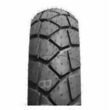
Learn more
Learn more

Learn more
Learn more
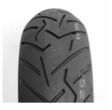
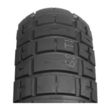
Learn more
Learn more

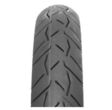
Learn more
Learn more
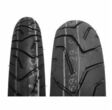
Learn more
Learn more
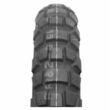
Learn more
Learn more
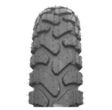
Learn more
Learn more
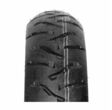
FAQ
What is the average lifespan of trail tyres?
The lifespan of trail tyres varies depending on several factors, including the type of tyre, driving conditions, and regular maintenance. Generally, high-quality trail tyres can last between 10,000 and 20,000 km, or even more under certain conditions.
However, it is important to regularly monitor tyre wear and condition and replace them as necessary to ensure safe and optimal driving.
Are trail tyres suitable for daily road use?
Yes, trail tyres are perfectly suitable for daily road use. Their versatile design offers excellent grip and high-speed stability, as well as precise handling in corners.
Whether for daily city commutes or long highway journeys, trail tyres provide reliable and comfortable on-road performance while maintaining off-road capability for adventurous rides.
How to choose the right tyre pressure for different driving conditions?
Choosing the right tyre pressure depends on your motorcycle manufacturer's specifications and driving conditions. It is recommended to consult your motorcycle owner's manual for specific tyre pressure recommendations.
Generally, for off-road driving, slightly lower pressure than recommended for road use can offer better traction and a smoother ride. However, adjust the pressure according to specific driving conditions and motorcycle load for optimal performance.
What is the difference between trail tyres and off-road tyres?
The main difference between trail tyres and off-road tyres lies in their design and intended use. Trail tyres are designed to offer optimal versatility, with balanced performance on and off-road.
They feature a more aggressive tread than standard road tyres but less pronounced than off-road tyres, providing reliable grip in various conditions. Off-road tyres, on the other hand, are specifically designed for off-road use, with a more aggressive tread for maximum traction on varied terrains.
Are trail tyres suitable for winter or snow use?
While trail tyres offer reliable grip on various surfaces, they are not specifically designed for winter or snow use. For safe driving in winter conditions, it is recommended to use snow tyres or all-season tyres, equipped with special treads and rubber compounds suitable for cold temperatures.
These tyres provide superior traction on snow and ice, ensuring safe driving even in winter weather.
How to maintain and extend the lifespan of trail tyres?
To extend the lifespan of trail tyres, it is important to maintain them regularly. This includes regular inspection of wear and deterioration, as well as maintaining optimal tyre pressure.
Avoid sudden braking and aggressive cornering to reduce premature tyre wear. Additionally, store tyres in a cool, dry place when not in use, and avoid hot or damp surfaces that can damage them.
Is it better to opt for tubeless or tube-type tyres for a trail motorcycle?
The choice between tubeless and tube-type tyres depends on personal preferences and driving conditions. Tubeless tyres offer the advantage of reducing the risk of slow punctures and facilitating on-field repairs. However, tube-type tyres can be easier to install and repair in case of a puncture.
Can trail tyres be fitted on any type of motorcycle?
Trail tyres can generally be fitted on a variety of motorcycles, but it is important to choose tyres that match your motorcycle's specifications and your riding style.
Ensure you select tyres with the correct dimensions and characteristics for your motorcycle, considering rim size and load and speed specifications. Consult your motorcycle owner's manual or a professional for specific recommendations.
Whether you are a seasoned adventurer or a budding rider, choosing the right trail tyres is essential for a safe and satisfying riding experience, both on and off-road.






